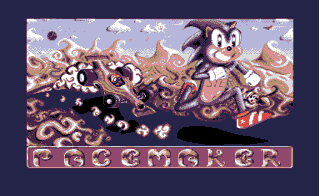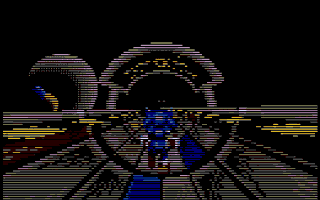. . . .........
. . ... . . . ...
. . . . .. ............
. . ... . . . . . . .....
_____ . . . .......__ __ __ . . ...__
/ ____ ____ ____ / / / ____ / __ ____ ___
/ _/ / / / __/ / _ / / / / / / / _/ / _ / / __
/ ____/ / _/ / / __ / __/ / __/ / / _/ / / _ / __/ / /
/ ___/ ___/ ___/ __/ __/ ___/ /_ ___/ /
. . . ... . . . . .. ........__/
. . .
. . . . . ..... Version 1.0 .
The Atari STe has always been a rather underrated and under-used machine in
comparison to its elder brother. I think this stems from the time when it
was originally launched, and people were generally underwhelmed by what the
machine had to offer. As I remember it, the pre-launch hype and rumour told
us to expect something closer to the TT, certainly a machine with an
enhanced cpu and screen modes.
The reality revealed a machine which looked 'cut-back' in those areas. It
did offer a new sound system, enhanced palette, hardscroll screen and the
blitter built in. However, the mainstream development community took one
look and decided not to bother. The STe was considered an improvement over
what came before, but not enough of one to take seriously.
The subsequent history of the STe continued in that vein. There was some
limited support of some of the extra hardware even when the ST was still
mainstream. This was almost covert in nature, and not widely known at the
time. It was easy for the game coders to slip in a routine to activate the
increased palette, so you got better colour scaling on Robocop 3 for
example, or a nicer looking raster background on 'James Pond'. Bizarrely,
this "partial" nature of using the STe hardware even extended to games like
'Vaxine' which were promoted for their STe enhancements at the time. That
one used the increased palette, but managed to avoid using Dma sound for the
in-game sample replay!
The news got a little better as the ST entered the twilight years. At last,
some decent hardware specific games such as 'Obsession', 'Zero-5', and
'Stardust' arrived. These were very late in the day, and much fewer than the
mountain of commercial games that were written for the STFM.
Of course there were demos, and these got into the hardware much earlier. We
fondly recall Aggression's "Brain Damage" demo as the ultimate STe demo.
Which is where it has stayed, as once again, not too many people have
explored the hidden depths of the STe's hardware. To some extent it has
suffered when the Falcon '030 came along offering new possibilities, and
didn't really benefit from the renewed interest in the ST from newschool
coders.
Now at least one group are considering the merits of the STe hardware, and
are seriously looking to make the ultimate brainblaster from it. These are
Paradox, consisting of Paranoid, RA, Zweckform, TNT, and of course ace muso,
505.
We say something of their potential with a couple of releases in 2004, with
the Photochrome busting 640 x 400 screengrab sideshow 'HiResMode' displaying
pictures in up to 14000 colours on a base STe. There was also the 'Xmas2004'
dentro, which gave a pretty good taster for what was coming next.
Strong rumours of a new STe demo from Paradox, to be shown at Outline '05
came true, and we were duly impressed. It won of course, but we had to wait
a little longer, whilst Paradox trimmed the rough edges off to make it
better than a 'party version'. Now it is finally here. Does it live up to
the brainblaster label?
Pacemaker is tied closely to the STe hardware. The readme file is at pains
to point out that it won't run on an STFM or TT, and that it will be mostly
ok on a Falcon. As for CT60, the advice is to switch down to '030 mode, as
the CT60 doesn't like the blitter too much, which is fair enough. I guess if
you ask about emulators, you will be deafened by the loud chorus of jeering
from Paradox HQ ;-)
Before I get stuck into the main body of the review, I'd like to thank
Paradox for their extremely helpful and informative readme file. This was
very helpful for reviewing purposes, especially with the technical
components, and describing in detail which bits of hardware were used for
particular screens.
So, starting the demo, and the first thing which appears on screen is a
parody of the warning hazard triangles which were popular in a Spice Boys
release at the SV2000 party. This one tells us of a 'Blitter hazard'. You
are to expect heavy useage of STe hardware!
A taster effect follows, consisting of a Copper/metal ingot 'Paradox' logo
on a plain screen and nothing else. This is topped by a neat bubble effect
bouncing lens magnifier. The helpful technical data supplied with the readme
says it is converted on the fly, and the blitter is used to get it onscreen.
Then, here is another understated and elegant effect. This is a bumpmap
screen, or two bumpmaps, with different colours and independent movement
patterns, in a nice 320 x 200 resolution. We are told it uses the hardware
scrolling and screen splitting features of the STe hardware.
Then we see the main title picture. This features the Sega icon, Sonic the
Hedgehog, and immediately we spot Paranoid's Sega fanboy influence on the
design of this demo! The Sonic theme reappears between screens as a little
picture insert, to describe what is coming next. For example, Sonic peering
into a telescope to "View the centre of the Earth" is the prelude to the
tunnel effect.

Paradox indulge in a little 'rotzoom' next. The 'Fake Radial Blur
Rotozoomer' is a large font text or texture. This is duly zoomed and
rotated, with a blurred afterimage in darkening blue shades. This confused
Felice momentarily who thought something might have been wrong with his Mega
STe, until I told him it was meant to look like that! The technical info
describes this as a pure blitter effect, as the cpu starts the ball rolling
by zooming and rotating the texture, but the blitter does all the rest.
This is one of the more intricate and "made for TV" parts of the demo.
Described as 'Smearing 3D blobs, it is a little bit like a starfield, but
with blobs rather than stars, and these motion-blur when they move, on a 3-D
axis. In fact, it's less of a starfield in motion, and more of a comet
frenzy! At the same time, Paradox made this their greetings screen,
fulfilling a double function. The greets use the same fade down as the
stars. The blitter is implicated here.
There is a second part, without greetings, where the blobs or stars bounce
up and down. It is simply an extension of the screen before.
Of course, to qualify as 'newschool', most demos have to have a classic DHS
style tunnel, or did that start with the Avena Dementia demo? There was a
time when this would have once been a cutting edge effect on the Falcon
'030. Now Paradox make it look easy on the STe. The effect is a double
alpha-layer tunnel, with an additional bright yellow light or flare which
perks up the sombre palette used for the tunnel. For such an impressive
screen, this makes little use of STe specific features, apart from the light
flare getting blitter assistance.
This effect is described in the readme as 'Linear Melt-O-Vision Blobs'. I'd
describe it as an onrushing starfield effect, but with solid blobs which
scale up as they come towards you, then fade out and melt. The blitter is
king once more as it carries out all the fading, zooming and melting, all at
once.
We come to the penultimate screen for Pacemaker. This is the "Moneyshot"
effect, which impressed us at Outline. If anything is 'brainblasting', then
this is it. Sonic the Hedgehog has a new job at Atari now. He's a large
sprite in the foreground, running down a solid and multicoloured textured 3D
half-tunnel. The viewpoint reveals he is running in space, with a distant
planetery background. The view closes in, then zooms out again. Then the
tunnel spins around.. Sonic continues his race for life, and a metallic
"ker-ching" can be heard over 505's sublime soundtrack, when Sonic picks up
tokens.

We are told this is a combined blitter and cpu effect. The cpu generates the
landscape and sprite, but the blitter makes it possible to handle the sprite
in realtime. The alternative method of pre-shifting in memory would have
needed 16 megabytes! The credits for this screen include an original Sonic
sprite and sample as supplied by Sonic Team of Sega!
And all good things must come to an end, and here is the endpart. This is
somewhat different compared to what came before. If anything, it most
closely resembles an oldschool amiga-ish screen, with rasters and distorting
vertical scroller, in a smart squareish font, and there is a disting 1
bitplane logo in the background running simultaneously to the scroller.
There is also a custom soundtrack by 505, which takes over from the nice
soundchip tune we had before.
There is overscan, the rasters use 4096 colours, and the distorting scroller
uses the STe's screen splitting capability. The soundtrack is depacked and
replayed in realtime using a new custom packing technique by RA.
So brainblasting or brain-numbing?
Well certainly not brain-numbing, in fact a good effort all round.
I hate to say this, but I think 'Brain Damage' is still in front. There was
a bravura and sheer theatricality to that demo, which sticks in the memory
and will be very hard to beat.
The approach of Paradox is a much more careful technical and considered one.
They are doing neat stuff with the STe hardware, it is well presented, and
has good design with a 'Sonic' theme running throughout. I would say it is
more of a 'coders' demo, where the cognosti spot how certain effects were
done, rather than a crowd-pleaser for the most part. We had to wait until
nearly the end for that jawdropping "Oh wow!" moment, when Sonic was
strutting his stuff in the STUN-Runner tunnel, but when he did, jaws were
duly dropped :-)
I get the feeling that they are still holding back a bit, and there is still
more to come from this team. The expertise is all there, they are the
masters of the STe hardware. Now if they can code some more 'big' screens
for the next one, then we might just have that Brain Damage beater at last!
RATINGS..
GRAPHICS:- 85% - Zweckform responsible for these, memorably cheeky Sonic
cameo cartoons between the main action.
SOUND:- 90% - They've got 505 on the team, how can they go wrong? Haunting
YM melody with Musicmon effects complemented by cool samples at the end.
GEE-WHIZ:- 88% - For copious use of STe hardware.
OVERALL:- 80% - A good solid demo, tends to be a more technical
demonstration rather than a multimedia brain-overload, apart from that last
but one screen of course :-)
CiH, for Alive! Mag,Nov '05
|



